
|   |

|   |
Dancing Soulscapes - Satish Suri e-mail: satishism@yahoo.co.in May 20, 2025 KUCHIPUDI BY RAJASHREE HOLLA 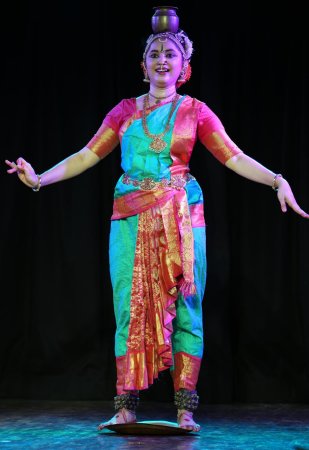 Rajashree Holla Photo: Prof.K.S.Krishnamurthy Rajashree Holla's Kuchipudi performance at M.E.S.Kalavedi on the 19th of April, offered a captivating portrayal, seamlessly blending technical precision with emotive storytelling. Beginning with the Patra Pravesha Daravu, she introduced the celestial enchantress Mohini through graceful movements, characterized by flowing mudras, expressive abhinaya, and rhythmic footwork that remained tightly synchronized with the nuances of the music. The choreography played ingeniously with the laya of mishra chapu. In one moment, she moved through the tala's three beats with sharp teermanams, her feet tracing crisp geometries; in the next, she dissolved into the four-beat phase with undulating mandis and spiralling bhramaris, as if the very concept of time bent around her. The jatis were interspersed with haunting sahitya, the lyrics describing her as "Maya Mohana Vilasini" - one who sports in the play of illusion. Rajashree embodied Mohini's ethereal charm with poise, portraying the delicate balance between allure and divine purpose. Her expressive interpretation highlighted Vishnu's wisdom in assuming a feminine form to uphold dharma, subtly invoking themes of cosmic balance, deception employed for a higher cause, and the role of divine intervention in restoring order. Adorned in traditional Kuchipudi attire, Rajashree's visual presentation further enhanced the celestial character of Mohini, lending a radiant presence to the stage. Her performance stood out for its narrative clarity and aesthetic finesse. Rajashree Holla presented a Sabdam, weaving together narrative richness and rhythmic intricacy. The piece centred on two significant episodes from the Ramayana - the redemption of Ahalya and the moral dilemma faced by Lord Rama when asked to slay the demoness Tataka. Rajashree skillfully portrayed the poignant moment of Ahalya's shapa vimochana - her release from a long-standing curse. Cursed to live as a stone for her unintended transgression, Ahalya was restored to her human form by the mere touch of Rama, a gesture laden with compassion and divine grace. The dancer's nuanced portrayal captured the emotional complexity of Ahalya's remorse, her silent suffering, and the transcendence that came with Rama's redemptive act. The performance then shifted to the episode where Sage Vishwamitra urged Rama to slay Tataka, a formidable demoness. Despite her being a woman, Vishwamitra appealed to Rama's sense of dharma, underscoring that her continued existence posed a grave threat to righteousness. Rajashree brought out the internal conflict within Rama - the tension between his innate sense of compassion and his unwavering commitment to duty. The portrayal culminated in Rama's resolute decision, a moment that illustrated his evolving role as the upholder of cosmic order. Vijayawada Shanti's evocative Ragamalika composition, interwoven with multiple ragas, served as the musical canvas for the performance, deepening both its emotional resonance and dramatic impact. The fluid transitions between ragas mirrored the shifts in mood and narrative, complementing Rajashree's dynamic presentation. Rajashree Holla concluded her Kuchipudi performance with a striking Shiva Tarangam, set to music by Rama Jagannath, with percussive accompaniment by Sri Hari and vocals by Balasubrahmanya Sharma. This climactic piece, based on a rare composition by Narayana Teertha, paid homage to Lord Shiva and served as a testament to her mastery of rhythm and devotion. Balancing a pot on her head while performing intricate footwork atop a brass plate, she embodied one of Kuchipudi's most demanding and iconic sequences. With every beat and movement, Rajashree maintained unwavering precision and grace, fusing technical brilliance with expressive bhakti. The performance unfolded as a seamless interplay of storytelling, rhythm, and spiritual fervour, capturing the essence of Shiva's cosmic energy and benevolence. Her interpretation resonated with themes of compassion, divine will, and unwavering duty, leaving the audience deeply moved and mesmerized by the depth and dynamism of her art. SATTRIYA BY MEENAKSHI MEDHI 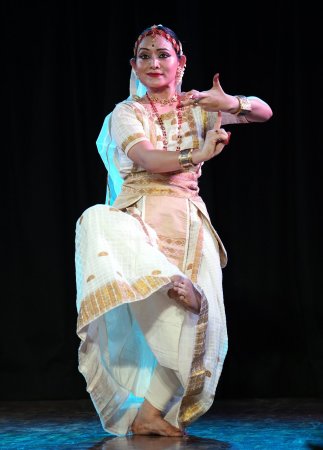 Meenakshi Medhi Photo: Prof K.S.Krishnamurthy Meenakshi Medhi's Sattriya performance,under the aegis of M.E.S. Kalavedi Festival on the 19th April was a masterful showcase of artistry, spirituality, and technical brilliance, embodying the essence of this classical Assamese dance form rooted in Vaishnavite devotion. Her recital, a seamless blend of rhythmic precision, expressive storytelling, and philosophical depth, captivated the audience, affirming Sattriya's power to transcend mere performance and become a medium of divine connection. The performance began with the Ramdani, a traditional invocatory piece in Sattriya that sets the rhythmic and spiritual tone for the recital. Known for its dynamic energy, the Ramdani highlighted the bols - the mnemonic syllables of the khol, a two-sided drum central to Sattriya's musical framework. Medhi's footwork was precise, each step resonating with the khol's intricate rhythms, creating a vibrant dialogue between dancer and musician. Her movements, fluid yet controlled, embodied the grace and discipline of Sattriya, with subtle hastas and gentle sways reflecting the form's monastic origins. The centrepiece of Medhi's performance was the Shloka Abhinaya "Sarata Sasanka Kara...", set in the evocative raag Sarang. The piece portrayed beloved episodes from Lord Krishna's childhood through the perspective of a devoted Gopi. This segment was a profound exploration of devotion, divine power, and the triumph of good over evil, rendered with emotional intensity and philosophical resonance. The narrative began with the Poothana episode. Sent by Krishna's uncle Kamsa, the demoness Poothana sought to kill the divine child by offering poisoned milk. Medhi's abhinaya was compelling as she portrayed Poothana's transformation into a beautiful woman - her deceptive allure conveyed through expressive eyes, delicate gestures, and nuanced facial expressions. The tension mounted as she approached baby Krishna, only to be vanquished when the infant effortlessly drew out her life force. The use of raag Sarang deepened the emotional poignancy of this scene. Transitioning into the Bakasura episode, Meenakshi captured the menacing energy of the monstrous bird demon. Set to raag Gauri, this segment was vibrant and intense, illustrating the predator's attack and Krishna's divine response. The victory over Bakasura was portrayed with quiet resolve - highlighting Krishna's calm strength and spiritual supremacy. The music composed by Prashanth Raj Khova, played a crucial role. The shift from raag Sarang's lyrical melancholy to raag Gauri's dramatic intensity mirrored the narrative's emotional arc. The khol's rhythmic foundation, paired with Medhi's synchrony and command over tempo, elevated the storytelling to a deeply immersive experience. Meenakshi transitioned next into Ankia Bhaona, a pure dance piece composed by Srimanta Sankaradev and set in Suta Taal, with music by Arnab Jyothi Baruah. This segment emphasized nritta, where rhythm, form, and spiritual essence take centre stage. Ankia Bhaona, though non-narrative, is rooted in devotional fervour and draws from the theatrical traditions pioneered by Sankaradev. Medhi explored this work with a meditative intensity. The Suta Taal's unique metric structure allowed her to display rhythmic dexterity - each beat marked by crisp footwork, graceful spins, and stylized hastas executed with economy and elegance. Her upright posture and flowing transitions reflected the aesthetic restraint of Sattriya, even as the piece pulsed with devotional energy. The dialogue between the dancer and khol continued seamlessly from the earlier pieces. Arnab Jyothi Baruah's composition retained the traditional tonalities of Sattriya, weaving together instruments such as the manjira and flute to create a luminous sonic backdrop. The dancer's ability to infuse each movement with spiritual weight, despite the absence of narrative, underscored her maturity as a performer. Meenakshi Medhi concluded her performance with a powerful depiction of the Savitri-Satyavan saga - an enduring tale of love, devotion, and triumph over fate. Scripted by Bhaskar Ojha and choreographed by Medhi, the piece emphasized abhinaya and philosophical depth within the Sattriya framework. Portraying Savitri, the princess blessed by the Sun God, Medhi embodied strength and grace through refined hastas, expressive abhinaya, and poised movement. The narrative traced Savitri's unwavering resolve to marry Satyavan despite a prophecy foretelling his early demise. Her dignified portrayal highlighted Savitri's love, courage, and spiritual resilience. The dramatic core unfolded as Yama, the god of death, took Satyavan's soul. Savitri's pursuit and dialogue with Yama were skillfully choreographed to convey her perseverance. Through strategic boons, she restored her father-in-law's sight and ultimately reclaimed Satyavan's life - an affirmation of wisdom and devotion. Medhi's minimal yet evocative gestures, and emotive expressions brought each character to life, concluding the performance with a celebration of spiritual strength and divine grace. The piece encapsulated Sattriya's core values - faith, devotion, and moral triumph - with aesthetic and emotional clarity. With impeccable technique and an infectious enthusiasm for the form, Meenakshi reaffirmed the relevance and beauty of Sattriya in contemporary performance spaces - transforming each moment on stage into an offering of devotion. M.B. NAVYASHREE'S SILVER JUBILEE BHARATANATYAM PERFORMANCE 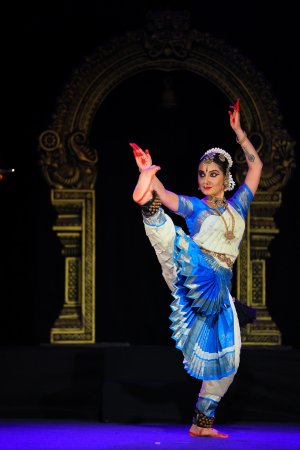 M.B. Navyashree Photo: Madhukar On the evening of April 26, 2025, the JSS Auditorium resonated with reverence and aesthetic splendour as M.B. Navyashree, a seasoned disciple of Charles Ma, commemorated 25 years of her Bharatanatyam journey with a Margam presentation. The evening commenced with a vibrant Pushpanjali, a traditional invocatory piece composed by Madurai Muralidharan. It was a ceremonial offering of flowers - symbolizing respect to the divine, the guru, and the rasikas. With precise adavus, radiant stage presence, and crisp geometry in movement, Navya Shree set a devotional and energizing tone for the evening. This was followed by "Om Kara Karini" in the raga Lavanthi, a composition by Balamurali Krishna. Here, the dancer's sensitive abhinaya brought forth the many facets of the Mother Goddess - compassionate yet fierce, nurturing yet formidable. Navyashree's fluid movements, marked by a controlled elegance, captured the essence of the Devi in all her resplendence. The use of delicate hasta mudras and a restrained yet evocative expression palette made this item particularly striking. The performance reached its emotional zenith with her rendition of "Swami naan undan adimai," a Varnam steeped in themes of devotion, longing, and surrender. It was here that Navyashree's artistry came into full bloom. She embodied the nayika whose soul yearns for Lord Shiva with unwavering intensity. Through deeply internalized bhava, she invited the audience into the inner sanctum of the devotee's heart. Every glance, every pause, every fleeting movement seemed choreographed by emotion itself. Her eyes, seemed to hold dialogues with the deity, turning the stage into a sacred space of intimate communion. The choreography, under Charles Ma's sensitive guidance, was a seamless blend of traditional nritta and interpretive abhinaya. The deliberate use of slow movement and silent pauses created a powerful contrast with more dynamic sequences, amplifying the emotional undercurrents. This mastery over tempo and rhythm not only showcased Navyashree's maturity as a dancer but also her ability to hold space and let the rasa unfold organically. In "Krishna nee begane baro," Navyashree portrayed the yearning of a devotee beckoning the playful Krishna to reveal himself. Her abhinaya was captivating, with delicate facial expressions conveying a blend of maternal affection and devotional longing. The iconic imagery of Krishna adorned with ornaments and playing his flute was vividly depicted. The choreography incorporated dynamic jathis that complemented the lyrical beauty of the piece, with Navyashree's spatial awareness enhancing the visual storytelling. Her ability to transition seamlessly between moments of exuberance and tender devotion kept the audience immersed in the divine narrative. Navya Shree then transitioned into a rendition of the ashtapadi "Sakhi he kesi mathana mudaram" from Jayadeva's Gita Govinda. This piece, steeped in the lyrical richness of divine love, showcased her ability to embody intricate emotions. Navyashree portrayed Radha's intense yearning and emotional turmoil as she confides in her sakhi about Krishna, the slayer of the demon Kesi. Her abhinaya was nothing short of spellbinding, with nuanced expressions capturing Radha's blend of love, vulnerability, and divine ecstasy. Her eyes sparkled with the pain of separation and the fervour of devotion, drawing the audience into the depth of Radha's heart. Each gesture articulated the poetic imagery of the ashtapadi with grace and precision. The choreography was a seamless fusion of slow, emotive sequences and intricate rhythmic patterns, reflecting the ebb and flow of Radha's emotions. Navyashree's footwork was crisp, navigating the complex talas with ease, while her fluid movements evoked the tenderness and passion of the divine love story. Her spatial awareness added a layer of intimacy, as she used the stage to create a dialogue between Radha, her sakhi, and the audience, enveloping them in the narrative. To conclude, she performed a sprightly Thillana in raga Valachi, a composition of Dwaraki Krishnaswamy. This vibrant finale, marked by brisk footwork and vivacious movements, provided a joyous contrast to the emotive intensity of the preceding pieces. It served as a fitting conclusion to an evening that was as much a celebration of Navyashree's artistic journey as it was a tribute to the timeless beauty of Bharatanatyam and the Vazhuvoor Bani. The lighting design subtly complemented the moods, never overpowering but always enhancing the visual narrative. The musical ensemble, with Rohith Bhat on vocal, Charles Ma on the nattuvangam, Vinay Nagarajan on the mridangam and Karthik Sattavalli on the flute were in perfect sync with the dancer, and provided a textured and emotive backdrop that elevated the performance. PADMA V. IYER'S BHARATANATYAM MARGAM 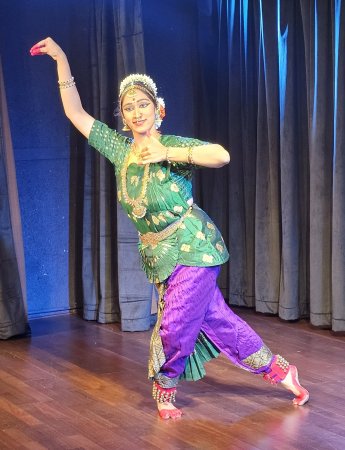 Padma V Iyer Photo: Subramanya Shastri Under the aegis of the ‘Every Day Friday' Cultural Program, Padma V. Iyer presented a thoughtfully curated Bharatanatyam Margam, resonating with devotion, lyrical beauty, and aesthetic refinement. The recital, performed to a recorded track, retained its emotive potency through precise choreography and internalized abhinaya. The performance opened with "Bhajamanasa", a traditional invocation to Lord Ganesha, composed by Tulsidas. Padma brought quiet reverence to the stage, invoking the remover of obstacles, radiant like a thousand suns. Her grounded presence and elegant execution set a spiritual tone for the evening. This was followed by a Sabdam in Kannada, composed during the Mysore court era - "Shankara Parameshwara" - where the Nayika expresses her devotion and surrender to Lord Shiva. The lyrical composition, suffused with love and reverence, found articulate expression in Padma's graceful movements and expressive subtlety, bringing alive the image of the cosmic dancer. The Varnam, "Simhavahini Rajarajeshwari", a composition of Madurai R. Muralidharan in raga Ranjani, set to rupaka tala, formed the central axis of the recital. A devotional ode to Goddess Rajarajeshwari, the work portrayed her as Simhavahini, the lion-riding mother goddess, a resplendent fusion of Gauri, Lakshmi, and Saraswati, and a divine embodiment of Parvati. Padma's performance delineated mythic episodes such as the slaying of Mahishasura, and her celestial dance (Tandava Mohini), portraying the goddess as a bestower of spiritual grace and worldly welfare. The choreography allowed a harmonious interplay between nritta and abhinaya, supported by vibrant jathis composed by Sheela Chandrasekhar, which Padma rendered with agility, precision, and rhythmic clarity. The Tamil Krithi "En pallikondeerayya" by Arunachala Kavi, set in Ragamalika, shifted the narrative to one of intimate devotion. A devotee marvels at the reclining form of Sri Ranganatha, gently questioning whether the Lord rests from the battles fought as Rama and Krishna. The choreography by B. Bhanumathi offered refined embellishment to this moment of sacred stillness. Padma's portrayal was marked by delicacy and meditative poise, embodying the Lord's divine exhaustion not as weariness, but as a gesture of serene love and fulfillment. The emotional undercurrent of surrender and wonder was conveyed with quiet intensity. A highlight of the evening was the Ashtapadi, "Sakhi hey Keshi", from Jayadeva's Gita Govinda. Through the eyes of Radha, the piece expressed profound longing, as she confides in her sakhi about Krishna, the slayer of the demon Kesi. Padma's abhinaya here was particularly compelling - each expression finely calibrated to reflect Radha's anguish, yearning, and divine passion. Her portrayal revealed a Nayika overwhelmed by her love for Krishna, caught in a confluence of devotion, vulnerability, and spiritual surrender. The recital concluded with a spirited Tillana composed by Lalgudi Jayaraman in raga Madhuvanti. With brisk jathis and a lilting melody, the piece served as a joyful finale. Padma executed it with crisp footwork, vibrant spatial movement, and an infectious sense of celebration. The gentle interweaving of rhythmic vibrancy and melodic charm provided an apt culmination to the evening. Though the performance used recorded music, the integration of sound and movement was seamless. The clarity and emotive quality of the audio supported the choreography with precision, and Padma's interpretive sensitivity ensured that the absence of a live orchestra did not detract from the performance's impact. 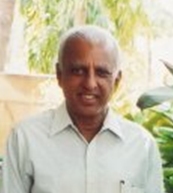 Bangalore based Satish Suri is an avid dance rasika besides being a life member of the Music and Arts Society. |